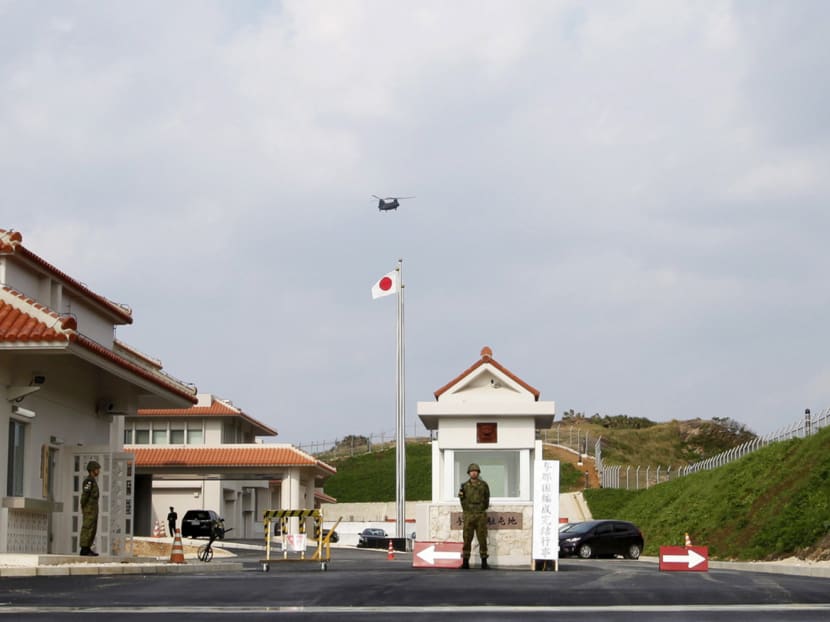Population decline on remote islands a problem for Japan
TOKYO — Japan is launching an urgent drive to shore up the population of 148 remote islands as it tries to head off new territorial disputes with China and South Korea.

A soldier from Japan’s Self Defence Forces keeps watch at the entrance of the military base on the island of Yonaguni in the Okinawa prefecture. The island is 120km from Taiwan but 2,000km from Tokyo, and has a population of 1,715. Photo: Reuters
TOKYO — Japan is launching an urgent drive to shore up the population of 148 remote islands as it tries to head off new territorial disputes with China and South Korea.
According to officials working on the plan, the government will legally designate the islands as inhabited border territories next month, with 71 singled out for special help due to their isolation and the severity of their population decline.
The effort highlights Japan’s acute sense of vulnerability as it tries to defend a sprawling archipelago of about 6,800 islands in a troubled neighbourhood and its overall population faces long-term decrease.
It follows the 2012 eruption of the dispute over the Senkaku Islands, known in China as the Diaoyu, which plunged relations with Beijing into crisis and has led to ongoing standoffs between fighter jets and coastguard vessels in the East China Sea.
The group of tiny islands once had a Japanese population of 200 but is now uninhabited. “If there were still people living on the Senkaku Islands then perhaps there wouldn’t be an issue with China,” said one official working on the policy.
Tokyo has a separate dispute with Seoul over the Liancourt Rocks, known as Takeshima to Japan and Dokdo to South Korea. They have been occupied by Korean coastguards for decades.
The population of Japan’s remote islands fell steadily from 1.3 million in 1955 to 636,000 in 2010. With the country’s overall population expected to drop from 127 million to 92 million during the next 40 years, that trend is expected to accelerate.
The new plan calls for the government to build civic facilities, buy land on the islands, improve ports and prevent illegal visits by foreign vessels. For the 71 specially designated islands, there is ¥5 billion (S$63 million) a year to subsidise transport and create employment for residents.
Mr Yaichi Tanigawa, a member of Parliament from the ruling Liberal Democratic Party, said letting islands become uninhabited is bad for national security. His constituency covers many islands in Nagasaki prefecture, including his birthplace in the Goto chain. “When I was a child, the population was 157,000. Now it’s about 55,000,” he said.
A second motive for the new law, said Mr Tanigawa, is to recompense islanders for the way their homes boost Japan’s exclusive economic zone. “Thanks to you, our economic zone is bigger,” he said. “It expands our territory sixfold.”
Among the most sensitive islands are the Tsushima group, where a population of 34,000 sits halfway between the Japanese and Korean mainlands. Past Korean land purchases on Tsushima have upset Japanese nationalists. The island of Yonaguni, which is 120km from Taiwan but 2,000km from Tokyo, has a population of 1,715 and now plays host to a radar station and garrison to monitor the Senkakus. The Daito and Ogasawara groups — each of which generates a huge Exclusive Economic Zone in the Philippine Sea — have populations of 2,107 and 3,029 respectively.
As well as the plan to sustain existing populations, Tokyo has been on an island-naming spree in recent years, christening hundreds of uninhabited islets with unlikely names to better assert their Japanese credentials.
Japan is also trying to re-grow coral on the atoll of Okinotorishima to support its claim that the reef qualifies as an island. Given the overall demographics, however, experts do not understate the challenge of keeping people in communities where their children have to leave to attend high school and the only career options are fishing and farming.
“Remote islands have disadvantages for industry, employment, transport, child-raising, education and welfare, hence the phenomenon of population decline is striking relative to the rest of the country,” said Mr Ainosuke Kojima, executive director of the Centre for Research and Promotion of Japanese Islands. Mr Kojima said the single most important factor in keeping people on islands was to develop industry and employment opportunities. “That is the principal object of the new law.” FINANCIAL TIMES






